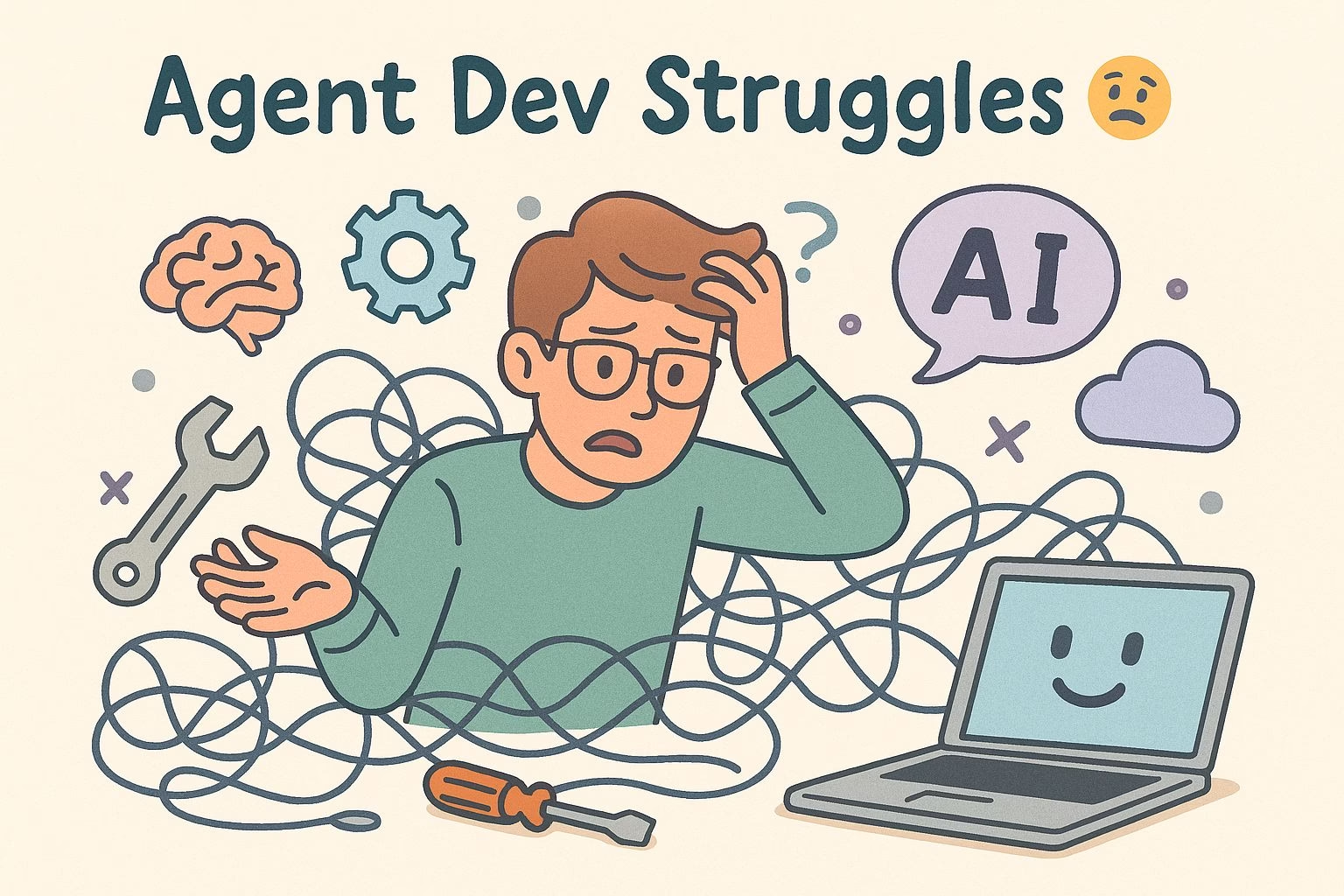What Developers Are Really Dealing With When Building AI Agents
If you’re building AI agents right now, you’re probably duct-taping tools together, debugging endless tool-call failures, and wondering if your workflow is more fragile than functional. You’re not alone.
I recently dug into a Reddit thread full of developers working on everything from toy agents to full-blown production platforms.
It’s a goldmine of hard-earned lessons, opinions, and recurring frustrations—especially around the tools we use, the tech stacks we commit to, and the unpredictable behavior of LLMs in the wild.
In this article, I’ll walk you through the key pain points developers are facing when building AI agents, along with some very real (and sometimes surprising) solutions that have worked for others.
The Real Pain of Building AI Agents
Let’s not sugarcoat it: building agents with LLMs is frustrating.
The most consistent complaint from developers? Lack of visibility. When something breaks (and it will), you’re left wondering:
-
Was it the tool call?
-
The prompt?
-
The memory logic?
-
A model timeout?
-
Or just the model hallucinating again?
There’s no unified view across the stack. You’re forced to stitch together logs from the agent framework, your hosting platform, your LLM provider, and any third-party APIs you’re calling.
The result is a debugging nightmare.
Even worse, agents tend to behave differently for the same exact input—which makes repeatability (a core requirement for any production system) nearly impossible.
This unreliability keeps developers from confidently shipping features, let alone trusting an agent to run autonomously.
And then there’s prompt-tool mismatch: you define a tool, feed it to your agent, and the LLM returns something totally unexpected—because it didn’t fully understand your schema or API expectations. You end up wasting cycles writing brittle glue code to patch the gap.
In short, the “intelligence” part of your agent is often the least reliable piece of the pipeline.
When Frameworks Get in the Way
Many developers start with tools like LangChain because they’re heavily recommended and appear “battle-tested.” But once inside, the reality sets in: these frameworks often introduce more complexity than they solve.
One developer put it best:
“I realized what I thought was an agent was just a glorified workflow.”
LangChain and similar frameworks are powerful—but they’re bloated. If you’re only using 10% of their features, you’re dragging around 90% of unused complexity, all while trying to debug something that could have been written in 50 lines of plain Python.
It’s not just LangChain either. Several comments mentioned how hard it is to pick a tech stack and stick with it. Frameworks keep changing, dependencies break, and what worked last month might introduce latency or bugs after an update.
Some devs are turning to lighter-weight tools like PydanticAI or even rolling their own agents from scratch to avoid unnecessary dependencies.
Others prefer modular setups with orchestration tools like n8n, which let them test and tweak logic without diving into complex codebases.
There’s a big takeaway here: if your agent is still in early prototyping or just handling basic tasks, you’re probably better off avoiding overbuilt frameworks.
Debugging Agents
Debugging AI agents is where most developers hit a wall—and it’s not just because of bugs. It’s the complete lack of transparency in how the agent operates.
When an agent fails, there’s no clear signal telling you where it broke. Developers are forced to reverse-engineer the entire flow:
-
Did the retriever return junk?
-
Did the model hallucinate tool output?
-
Did the memory component forget a key input?
-
Was the tool call malformed—or just ignored?
One developer described it as debugging in the dark, with only a flashlight and no map.
What makes it worse is the stochastic nature of LLMs. Even if you fix a prompt or change the order of instructions, the next run might still fail—for a totally different reason.
To cope, some developers are building their own observability layers using Cloudflare AI Gateway or running proxy workers that inspect token usage, logs, costs, and raw requests.
Others rely on LangSmith to trace prompts and tool interactions in real time—but admit it’s still early in terms of reliability.
In other words: tooling helps, but you’re still very much on your own when the agent goes rogue.
The Ideal Workflow Developers Wish They Had
After months of trial and error, a few developers have pieced together dream workflows that are surprisingly pragmatic.
One of the most shared setups includes:
-
A proxy layer (e.g. Cloudflare Worker) that routes every LLM call, logs token usage, and gives full visibility into costs
-
A modular agent backend running on something simple like FastAPI, Docker, or ECS
-
Cursor or similar devtools to test prompts, code, and UI tweaks in a tight loop
-
Lightweight orchestration logic using tools like
n8nor Google ADK for quick visual feedback
This kind of stack gives developers control over every part of the flow—from the moment a user message hits the backend to when the LLM returns a response. It also ensures you’re never flying blind on token spend or agent behavior.
But the best part? It makes iteration fast. You can test, tweak, and redeploy without waiting for huge retraining cycles or complicated deployment pipelines.
A few developers are even sharing their boilerplates publicly, like https://atyourservice.ai, to help others skip the painful discovery process.
Deployment and Scaling Considerations
Once your agent works in testing, the next hurdle is deployment—and that’s where a lot of builders hit another wall.
Some developers go with platforms like Supabase or Backend-as-a-Service (BaaS) tools for quick setups. But many later regret it. Why? Because these platforms often come with limitations:
-
They don’t scale cleanly for more complex agent workloads
-
You might run into pricing cliffs as soon as your app gains traction
-
You lose flexibility to fine-tune backend behavior
One experienced dev put it bluntly:
“If you can, don’t get locked into BaaS too early. You’ll want the freedom that comes with AWS or Azure later.”
Others are already running agents on Docker + ECS, with a preference for familiar setups that let them control performance, memory, and retry logic more tightly.
Cloudflare Workers were mentioned repeatedly—especially for the proxy layer—because of their tight integration with observability tools and low-latency performance.
If you’re planning to move from hobby project to production, it’s worth thinking about deployment early. Don’t assume your initial host will scale with you.
Smart Stack Choices and Tools That Work
The Reddit thread revealed some interesting tool combinations that developers swear by—many of which balance cost, performance, and visibility.
Here are a few of the standout combos:
1. LangChain + LangSmith
Still messy, but widely adopted. LangSmith helps trace what’s happening during complex workflows and tool usage, though it’s far from perfect.
2. Mistral + Claude
Several devs are routing different tasks through Claude (for higher accuracy) and Mistral (for lower cost). Some are experimenting with traffic-splitting setups using LLM routers like ArchGW to dynamically manage the balance.
3. FastAPI + Supabase
FastAPI remains a popular backend for agent logic. Supabase is used for state storage or quick MVPs—but again, with a warning not to rely on it long-term.
4. CrewAI
A rising star for multi-agent coordination. It’s praised for its clean design—but some users noted serious slowdowns and bugs introduced in recent updates. Still, it’s a compelling alternative to chaotic multi-agent setups.
5. n8n
Used to orchestrate LLMs and tools without diving into code-heavy frameworks. Developers love how easy it makes debugging and routing prompts.
These stacks show there’s no one-size-fits-all solution. Your agent’s purpose, complexity, and budget all influence which tools will actually help versus hurt.
Optimization Opportunities Developers Are Begging For
If there’s one thing agent builders agree on, it’s that a lot of repetitive work still hasn’t been automated.
Here’s what developers wish they had:
-
Automatic tool schema mapping — Imagine if your API tools could automatically generate LLM-friendly docstrings or OpenAPI specs, instead of needing hand-crafted instructions.
-
An agent “test harness” — Developers want a built-in testing framework that simulates common failure modes, like:
-
Tool not being called
-
Wrong parameters
-
Hallucinated outputs
-
Response quality drops after retries
-
-
A real UI for live debugging — Something more robust than LangSmith, with full traceability and editable flows. The ability to watch and tweak your agent’s thought process in real time is still just a dream for most.
-
Better memory management — Agents quickly lose track of what happened two steps ago. Developers want memory modules that can handle retries, interruptions, or looping without needing to patch everything manually.
Despite all the buzz around AI agent tooling, there’s a big gap between what frameworks promise and what real developers need. Most workflows are still full of duct tape and workarounds.
Final Thoughts and Emerging Trends
As chaotic as the AI agent ecosystem is right now, one thing is clear: developers are learning fast.
What started as blind experimentation is turning into opinionated engineering. People are building opinionated stacks. They’re sharing best practices. And they’re dropping tools that don’t earn their keep.
Some are adopting multi-agent setups. Others are laser-focused on single-task repeatability. Many are moving toward self-hosted tools, better visibility layers, and frameworks that don’t try to outsmart them.
If you’re just getting into this space, here’s some advice distilled from the community:
-
Start simple. Complex workflows break.
-
Choose boring, repeatable use cases to begin with.
-
Pick tools that give you control, not just convenience.
-
Don’t trust the hype—trust your logs.
The AI agent space isn’t fully baked yet. But with the right stack, a bit of patience, and a strong debugging layer, you can build something that actually holds together.

